22 Feb Chain Maintenance Tips, with Ben Wood from Wheelbase
Chain maintenance tips from Ben Wood, Wheelbase Yorkshire bike mechanic
Here’s some easy maintenance tips to help you keep your pride and joy running. All those winter and spring miles take their toll on your bike, so here’s what to look for. My first instalment is on chains and how to look after them.
Chain wear and what to look for
Check your chain on a regular basis, you can get a chain checker or chain wear indicator from most cycling tool makers, but my personal favourite is the Park tools chain wear indicator. It’s very simple to use, if you don’t have one pop in and buy one or get us to measure your chain. A worn chain can cause massive problems if left and cause so many more issues to your transmission.
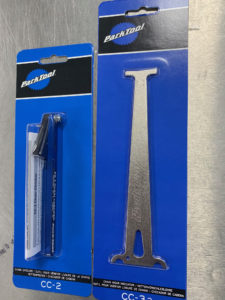 Out of all the components on a bicycle this can be the most abused and neglected component. Without your chain, you and your bike aren’t going any where fast.
Out of all the components on a bicycle this can be the most abused and neglected component. Without your chain, you and your bike aren’t going any where fast.
Most new chains measure at the 0.25 – 0.5 measurement. If your chain is getting close to the 0.75 – 1.0 measurement get it changed. I often change my chains 2-3 times per year before changing my cassette. This can change depending on the ratios, cadence and the weight of the rider, all effecting chain stretch. If you spin 90-100rpm then you will find a chain will last you longer than if you spin at a lower 70-80 rpm. Rider weight can also stretch chains faster. Imagine driving your car with low revs and always going up hill in 4th gear, before long you will need a new gear box as well as burning massive amounts of fuel.
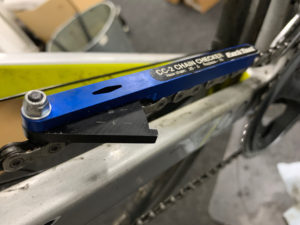
Smooth easy shifting can also save your chain, get in the correct gear before the climb starts and keep an even cadence. Many great bike riders are always changing gear, smoothing out the lumps. Also keeping the chain and cassette clean and well lubricated can make a big difference. Lubricate your chain once to twice a week depending on weather conditions. If you never clean the old oil off this will build up and cause more premature wear on the chain and attract dirt and road grime on to the chain.
A clean, well lubricated chain can also be more efficient and also save you valuable watts. In a world where most bikes are going aero to save your precious watts, you can save some energy by looking after your chain. Recent studies have shown a badly stretched chain can lose you up to 12 watts, compared to a new well lubricated chain only costing you 6 watts per revolution. That’s a 50% saving.
What chain should I use?
Depends on what transmission system you are using, Shimano, Sram or Campagnolo. Personally I would always stick to what the manufacturer recommends. So if you are using a Shimano transmission stick with Shimano. Shimano use a directional chain on all there latest group sets to improve shifting. All new Shimano chains now come with a quick link as this was often why many riders would choose to use another manufacturers chain like that of Sram or KMC chains as they have always used a split link.
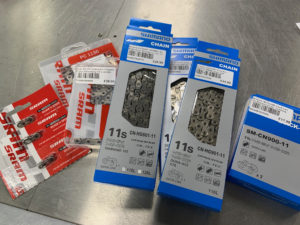
If your wanting the fastest gear changes stick with Shimano and can even improve shifting on Sram’s 11spd set ups. Sticking with manufacturers guide lines is key if you also wanting to keep your warranty on your components. So make sure when your replacing your chain don’t get tempted to run something cheaper from another manufacturer and compromise shifting and warranty.
Also using a professional mechanic and workshop is always best practice as if you do come in to any warranty issues with a new chain breaking they can help you with warranty and back you up that the chain was fitted by a professional correctly. Also the mechanic can investigate and check the transmission to get to the bottom of why the chain has broken. Bent rear mech hangers, damaged chain rings or worn components are often found to be the cause. Sometimes you can just be unlucky and debris can bounce up to damage components, this often happens more on mountain bikes, but as gravel bikes and cyclocross becomes more popular we are seeing more issues like this happening.
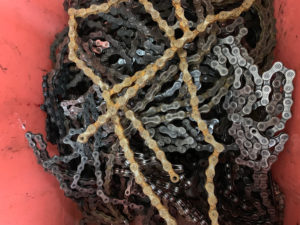
Why do chains break?
Many chains break from being badly worn or from bad shifting and maintenance. If a new chain has just been fitted and has been badly fitted a chain can break from this or sometimes but very rarely from a manufacturing issue. It’s very rare that a chain has been made with a fault, but a great mechanic will be able to often spot why, so keep the chain, so it can be inspected. Most broken chains are from being poorly fitted or set up the wrong direction. Also chains can break if you are fitting them on to old components. Have a professional mechanic check out your chain rings, cassette and jockey wheels as these can all cause wear to the chain.
How do I keep my chain running smoothly?
Keep your chain clean and well lubricated. Use a chain bath to clean the old oil off your chain or if you pushed for time Muc-off offer a range of cleaning products that can help clean and decrease without removing your chain. If you do this I always find the best practice is to degrease your chain first then fully wash the bike to make sure you get rid of all the degreaser off the chain and bike. If the degreased is left on this can break down the new oil and end up with a rusty, dry chain in no time.
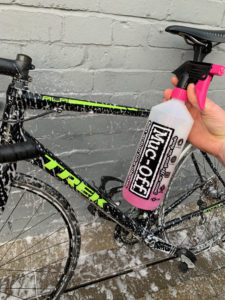 Be careful when removing split links as they are only really designed for one use. It’s always worth carrying a spare split link with you while on long rides as well as a good quality chain tool. Cheap chain tools can cause just as many problems to a new chain as wear and tear can. In the workshop the chain tool i use by Shimano costs over £100 and the quality of the tool helps the mechanic fit the chain perfectly every time. I see many chains snap do to a rider fitting it with a really worn chain tool which damages the links of the chain when shortened and fitted.
Be careful when removing split links as they are only really designed for one use. It’s always worth carrying a spare split link with you while on long rides as well as a good quality chain tool. Cheap chain tools can cause just as many problems to a new chain as wear and tear can. In the workshop the chain tool i use by Shimano costs over £100 and the quality of the tool helps the mechanic fit the chain perfectly every time. I see many chains snap do to a rider fitting it with a really worn chain tool which damages the links of the chain when shortened and fitted.
After cleaning make sure you chose the right lubrication for the job. Wet ceramic lubes can be perfect for the winter or wet weather. If your riding in dry conditions chose a dry ceramic lube. Generally the more you spend on lube the better quality and performance you get. Make sure to always keep degreasers and lubricants away from brake surfaces and bearings. I often wash my bike after degreasing the chain to make sure all degreases have been removed before lubricating.
If you unsure on how to remove or fit a chain then don’t hesitate to get in touch, we are always on hand to help.
Many thanks
Ben

Sorry, the comment form is closed at this time.